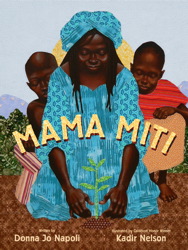March 27 - Today's post contributed by Valarie Budayr
By Valarie Budayr
“ It’s the little things citizens do. That’s what will make the difference. My little thing is planting trees.”
She was called Mama Miti ,which means Mama Trees, by many people in Kenya Africa. I first heard of Wangari Maathai when she won the Nobel Peace Prize in 2004 for her contribution to sustainable development, democracy, and peace. She was the first African woman to win this honor.
 |
| photo credit www.nobelprize.org |
There is a wonderful children’s book recently published called Wangari Maathai: The Woman Who Planted Millions of Trees by Franck Prevot and Illustrated by Aurelia Fronty.
Wangari Maathai was remarkable on many levels. Born in 1940, the eldest of six children, it was thought that she would be the second mother in her family and help raise the other children. When Wangari was 8 years old she moved with her mother and two brothers from the farm in the Kenyan countryside to a village which had a school so her brothers could attend. Her brother asked why Wangari didn’t go to school ? This question prompted Wangari’s mother to let her go to school. Wangari had a full education and in 1960 when British colonialism ended, President Kennedy of the United States invited many young Kenyans to study at Universities in America.
Wangari Maathai studied at Mount St. Scholastica College in Aitchison, Kansas where she received a bachelors degree in Biology. She then went onto graduate school at the University of Pittsburgh where she earned a Masters degree in Biology. After finishing her degrees in the US she returned to Kenya where she worked as a research assistant in zoology. Through travel to Germany and then back again to Nairobi and amid much political strife, Wangari received her Ph.d in Veterinary anatomy from Nairobi University. The first woman to do so.
 |
| photo credit Martin Rowe www.takingrootfilm.com |
From this point on Wangari knew how to make use of her education. She would tell leaders and her fellow Kenyans about the importance of trees. “A tree is a treasure that provides shade, fruit, pure air, and nesting places for birds. “ Change happened very slowly. In 1977 she created the Green Belt Movement. Traveling from village to village, speaking on behalf of trees, animals, and children, she encouraged villagers to think about their future. Teaching women to plant tree nurseries in each village, she provided women with a financial bonus for each tree that grew. One tree turned into thousands, thousands of newly planted trees turned into millions. To date over 30 million trees have been planted in Kenya creating forests for the future.
As her Green Belt Movement continued to grow she had another problem facing her. The Government made their money by cutting down trees and forests and here was Wangari Maathai planting trees. There was a conflict between Wangari, her Green Belt Movement, and the Kenyan Government. In her quest not to let one more tree be cut down, Wangari rallies her friends to fight the bulldozers which cut down trees for large real estate projects.
 |
| photo credit Martin Rowe www.takingrootfilm.com |
She ran for office many times opposing President Daniel Arap Moi. In a last ditch effort President Moi tried to divide the people in order to remain president. He knew that if that tribes would start fighting each other they wouldn’t have time to look at how he was governing. Wangari and the Green Belt Movement were onto President Moi and foiled his plans. Wangari suggested to each tribe that they offer trees from their nurseries to neighboring tribes as symbols of peace. Tree by tree, peace and friendships were cultivated between the tribes of Kenya.
Eventually in 2002 President Moi was defeated. Wangari Maathai won her bid for office in parliament and spent her last years creating a fair nation for women, men, children and trees.
 |
| photo credit www.plant-for-the-planet-billiontreecampaign.org |
To this day the Green Belt Movement is planting trees and protects the 2nd largest tropical forest in the world.
Wangari Maathai: The Woman Who Planted Millions of Trees is a beautiful tribute to a life well lived. Filled with colorful and vibrant painted illustrations. This book will become a cherished addition to your library as well as an inspiration to make a difference.
 Valarie Budayr is publisher at Audrey Press, founder of the award winning website Jump into a Book, and co founder of Multi-Cultural Children’s Book Day: Read Your World.
Valarie Budayr is publisher at Audrey Press, founder of the award winning website Jump into a Book, and co founder of Multi-Cultural Children’s Book Day: Read Your World.




















